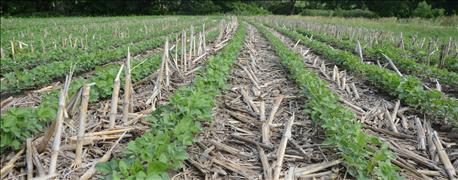
After a series of heavy rain events in different parts of Nebraska, crop progress is highly variable across the state. Here's a look at how things are shaping up in different parts of Nebraska:
East central
In east central Nebraska corn ranges from recently replanted to corn planted from April 12 to 17. "There's corn that's probably just been up at V1, just recently replanted. Then there's corn that's almost waist high in places," says Nathan Mueller, UNL Extension cropping systems educator in Dodge and Washington counties. Soybeans growth is similar, with those planted in early May at V2 to V3. "We don't have any soybeans canopied. We still have a little while to go."

CORN PROGRESS: In southeast Nebraska, corn crop progress ranges from recently emerged to V5 and V6. "Anything that got planted April 15 to 16 looks pretty good," says Tyler Williams. "Then the rain started and that put everyone behind. It seemed there were a lot of places drowned out or had limited growth with all the rain and saturated soils the first part of May and April. But on the fairly well-drained soils where the corn was planted early, it looks great."
As a result of sporadic rainfall events throughout late April and early May, stands have taken a hit from damping off due to seedling disease, as well as chilling injury, says Mueller. Meanwhile, in this part of the state, where hillside seeps are common, nitrogen loss has been a concern for some, and growers have been sidedressing for the last couple weeks.
"We've had some days where the humidity was high and it was windy, so a lot of the corn last week already starting to roll up due to a combination of water use and heat stress. The plants were transpiring enough water, and the root system wasn't robust enough to extract that water from the soil fast enough. It's almost kind of a flash drought flash response," Mueller says.
However, on Saturday, parts of east central Nebraska received massive amounts of rainfall – especially in Dodge County, where some received 7 to 8 inches.

SOYBEAN PROGRESS: Soybeans in southeast Nebraska range from those that haven’t emerged to first trifoliate. "Most of the soybean acres didn't get planted until mid-May. Some were delayed quite a bit because soils weren't very well drained," says Tyler Williams. "There are some that had just been planted and haven't even emerged yet."
South central
Corn growers in south central Nebraska are experiencing that same variability after wet weather drowned out stands and they had to replant those patches. However, much of the corn in south central Nebraska was planted in late April/early May, and is reaching the V6 to V9 stage now. Meanwhile, soybeans range from just emerging up to V4, and with the earliest planted at V5.
~~~PAGE_BREAK_HERE~~~
And depending on how far along the corn crop is, the crop is showing signs of short-term moisture stress. "Shorter corn may not have a root system in moisture right now and taller corn may have leaves rolling due to the heat and wind drying out the top seven inches of soil," says Jennifer Rees, Extension educator in York and Seward Counties. "There's good moisture in the subsoil. Our recommendation is to allow that taller crop to root down if you're in heavier textured soils with subsoil moisture."
In this part of the state, there has been concern of seedling diseases causing damping off in corn, and growers are seeing discoloration on lower leaves – a symptom of anthracnose. While there is concern of nitrogen loss, many growers in the region have been moving toward in-season applications to avoid loss to leaching and denitrification. "We've been recommending growers take soil samples in areas where water ponded, and we've been recommending more in-season applications to avoid leaching and the loss of N, not just for environmental reasons and to help the pocket book," Rees says.
Southeast
In southeast Nebraska, corn crop progress ranges from recently emerged to V5 and V6. "Anything that got planted April 15 to 16 looks pretty good," says Tyler Williams, University of Nebraska Extension educator in Lancaster County. "Then the rain started and that put everyone behind. It seemed there were a lot of places drowned out or had limited growth with all the rain and saturated soils the first part of May and April. But on the fairly well-drained soils where the corn was planted early, it looks great."
Soybeans are more behind – from those that haven’t emerged to first trifoliate. "Most of the soybean acres didn't get planted until mid-May. Some were delayed quite a bit because soils weren't very well drained," Williams says. "There are some that had just been planted and haven't even emerged yet."
Keith Glewen, Extension educator in Saunders County, notes one of the challenges is sidewall compaction from traffic in wet soils, along with ponding and runoff have left stands variable.
~~~PAGE_BREAK_HERE~~~
"Stand variability is terrible just because of the water and soil movement. We've got silting in. We've got ponding. We had erosion washing rows out, washing the plants out," Glewen says. "Then you get those hard rains and the ground in this part of the country gets hard and tightens up. It just doesn't look pretty."
However, parts of southeast Nebraska received over 2 inches of rainfall over the weekend. And the hot weather in recent weeks has provided ample heat units for the corn crop to take off. "If the crop has found the nitrogen, it's starting to change its appearance," Glewen says. "The crop has really taken off in the last couple weeks."
About the Author(s)
You May Also Like






